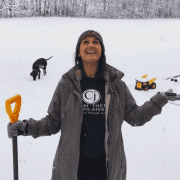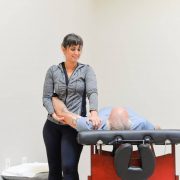The Snow is Coming… 5 Tips to Avoid Hurting your Back
When you live in New England, there is no doubt that at some point you will HAVE to shovel snow.
There are some pros — like it being a good workout and getting out into the fresh air. But for the most part, this activity is known for its cons — that it’s cold, wet, and quite literally, “back-breaking.”
While I can’t help you with the cold and wet part, I CAN help you learn how to protect your back. Here are some tips that I give to my own patients with regard to shoveling.
- Shovel early, and frequently. It might feel nice to sit by your fireplace with a hot cup of cocoa, watching the snowflakes fall, but you’ll regret it later. As you wait, that snow is likely to turn into a heavy, wet mess. It’s best to get out there early, while the snow is still lighter and fluffy, and just shovel in smaller, more frequent chunks. Doing any activity more frequently but for a smaller amount of time — say 20 min — will lessen the amount of stress put on your spine.
- Use your legs. The last thing we think about when it comes to shoveling is proper form. However, form is critical if you want to protect your back! Our spines were designed to have enough endurance to hold us upright and maintain good posture — NOT to lift heavy things. That’s what our glutes and legs are for! Save your spine by using the power of your legs to lift the snow. Bend your knees, stick your bottom out, and lift that snow with your whole body instead of curving over from your spine. Your legs might be sore from all that squatting, but your spine will thank you.
- Don’t twist, pivot. Once you lift the snow, you’ve got to throw it away. You want to use your whole body to pivot, not twist. When discarding the snow, many just twist their upper body and rotate from their spine, letting their arms and trunk do all the work. Instead, you want to pivot with your whole body by keeping your pelvis (the front of your hips) facing and in line with the shovel throughout the whole movement. If your shovel and arms have gone one way, and your hips are still pointing forward, you’re twisting instead of pivoting (and that is asking for trouble)!
- Breathe and use your core. No matter what, make sure you’re breathing! When you hold your breath, your deep abdominals can’t function fully. Additionally, the extra pressure that builds from holding air inside your abdomen has to go somewhere — like into your spine. Prolonged, extra pressure can push out on your discs and make them more vulnerable, especially in a forward-bent position like shoveling. In a proper breath, your diaphragm pushes the air down, your abdominals stretch out a little, and then naturally recoil back. This automatic recoil allows your abdominals to contract and support your spine. Rule of thumb —make sure you’re always breathing, and exhale for better abdominal support when lifting the snow.
- Make it easy on yourself. If you absolutely must shovel snow and can’t get someone else to do it for you (my favorite tip!), make it as easy on yourself as possible. You can decrease the repetitive strain on your body by using an ergonomic shovel or snow blower. But remember, even with a snow blower, you still need to use your legs, breathe, and engage your core while maneuvering the machine. Just because you aren’t doing all of the heavy lifting doesn’t mean your back won’t still end up in a vulnerable position.
If you’ve ever hurt your back shoveling snow, and want more information and tips like these, click here for a free copy of the back health guide we give to our very own patients!



